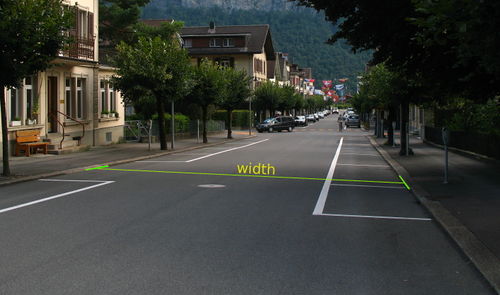|
When measuring the width of a way, do you measure from gutter to gutter, or shoulder-line to shoulder-line, for example; or, do you exclude the area taken up by habitual on-street parking? |
|
I would measure the with from kerb to kerb or end of the paved area if there is no kerb.
That there is street parking possible can be indicated by a tag with the key Definitely I would include the parking space if it is subtracted from what is a driving lane if no one parks there ... I am not that sure about the shoulder. If there is a Some further thoughts:
Okay, so, what if a way with a We have currently 2037 Or tag the width of the shoulder in addition to the overall width: I assume, that in the beginning of OSM, when there were no Thanks for
(10 Apr '16, 07:28)
samuelrussell
1
You need to be a little careful with some of these taginfo numbers - in some cases they've been created either mechanically or by humans, but without brain being in gear. For example, I randomly picked a "shoulder:width" and got to http://www.openstreetmap.org/way/391523093 . Obviously (both logically and from the imagery) there's no shoulder at all here - clearly the way for the main carriageway has been split and the extra tags simply haven't been noticed.
(10 Apr '16, 10:23)
SomeoneElse ♦
@SomeoneElse: thanks for the note, indeed, I quoted those numbers just for ease of reading (no need to click through to taginfo each time if you want to know the number). High numbers do not necessarily mean that a tag is used by many mappers or is useful and well-thought-out at all.
(10 Apr '16, 11:10)
aseerel4c26 ♦
|
|
I read the following:
1
Whilst you can of course use any tags you like, a quick look at the usage of https://taginfo.openstreetmap.org/keys/parking%3Alane%3Aleft%3Awidth shows that only 3 mappers worldwide are using it. It's likely that the only maps using that data will be ones that they create. "roadreserve:width" isn't used at all; you'd need to both explain what it meant and persuade other people that it's useful with that one.
(10 Apr '16, 10:27)
SomeoneElse ♦
I'm more pointing out the variety of objects that a
(10 Apr '16, 21:58)
samuelrussell
|



